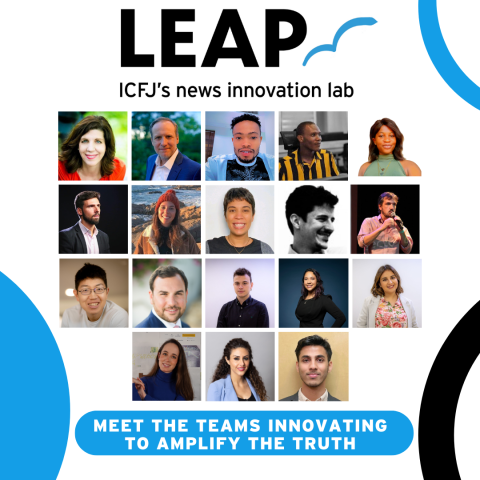
Eight newsroom teams from the U.S and around the world will develop products and processes that harness AI to amplify truth and combat mis- and disinformation, as part of ICFJ’s Leap Innovation Lab kicking off this week.
ICFJ’s Leap Innovation Lab chose the teams from almost 400 applicants based on their potential to use AI to create prototypes to counter manipulated content. Proposals range from tools to track the origin and flow of disinformation across platforms, to automating verification and responses to user queries about dubious claims. At the end of the program, the teams with the most innovative solutions will receive funding to further develop their ideas into real-world tools.
"AI tools have become incredibly powerful and accessible – both for bad actors and for good," said Maggie Farley, ICFJ’s senior director of innovation. "We're challenging these teams to leverage AI to safeguard integrity and trust in news.”
Nobel Peace Prize winner Maria Ressa will open the program, talking about how disinformation is the “atom bomb of our information ecosystem” and ways to actively address it. NYU professor Meredith Broussard will work with teams on how to keep bias out of training models.
Over 12 weeks, experts will train participants on design thinking, detecting and tracking manipulated content, championing ethical AI use, and accelerating fact-checking. Teams will have access to insights and tools from partners like WhatsApp, Microsoft, GPTZero, DFRLab and Adobe to develop products and processes that use AI to stem disinformation. The teams will be paired with mentors to build prototypes and to receive grants to further implement their ideas.
Gallery of speakers and experts:
Maria Ressa, Nobel Peace Prize winner, founder of Rappler.com
Meredith Broussard, NYU expert on AI and bias
Edward Tian, founder, GPTZero
Jean Le Roux & Max Rizzuto, DFRLab
Mattia Peretti, former manager of JournalismAI at LSE
Dalia Hashim, AI and Media Integrity, Partnership on AI
Liz Danzico, Design Engagement Experiences, Microsoft
Meet the teams and their goals:
AP (U.S.) - Create a set of verification tools for AP newsrooms
Chat VE (Nigeria) - Classify data and automate an AI tool to tackle disinformation, especially in elections
Correio Sabiá (Brazil) - Refine Platō, an interactive platform that brings audience’s questions directly to journalists and vetted experts
Desconfio (Argentina)- Use large-scale data analysis to create an early-warning system for disinformation flows
Rolli - Information Tracer (Singapore/U.S.) - Track and analyze the spread of disinformation across multiple platforms
Maldita (Spain) - Introduce automated text responses for citizens in its WhatsApp Chatbot, specifically to answer climate change queries, linked to its disinformation database tools.
Serendipia (Mexico) - Use AI to analyze government contracts and other very large documents to verify information and identify false information
Sourceable (MENA/US) - Use AI to authenticate content and distribute information for MENA diaspora audiences
We are immensely grateful to the dozens of individual donors who have made this initiative possible by contributing to our It Takes a Journalist campaign, which we designed to help journalists meet the most urgent issues of today. Their support allows us to flexibly deploy resources where they are most needed.
Learn more about ICFJ’s Leap Innovation Lab and the first Solutions Challenge.